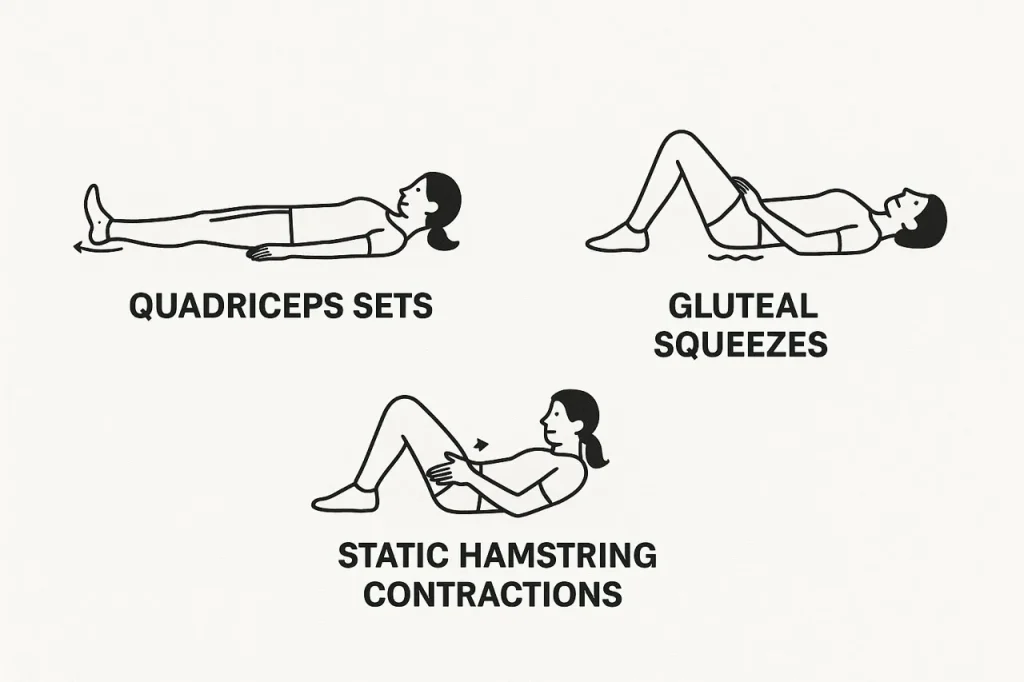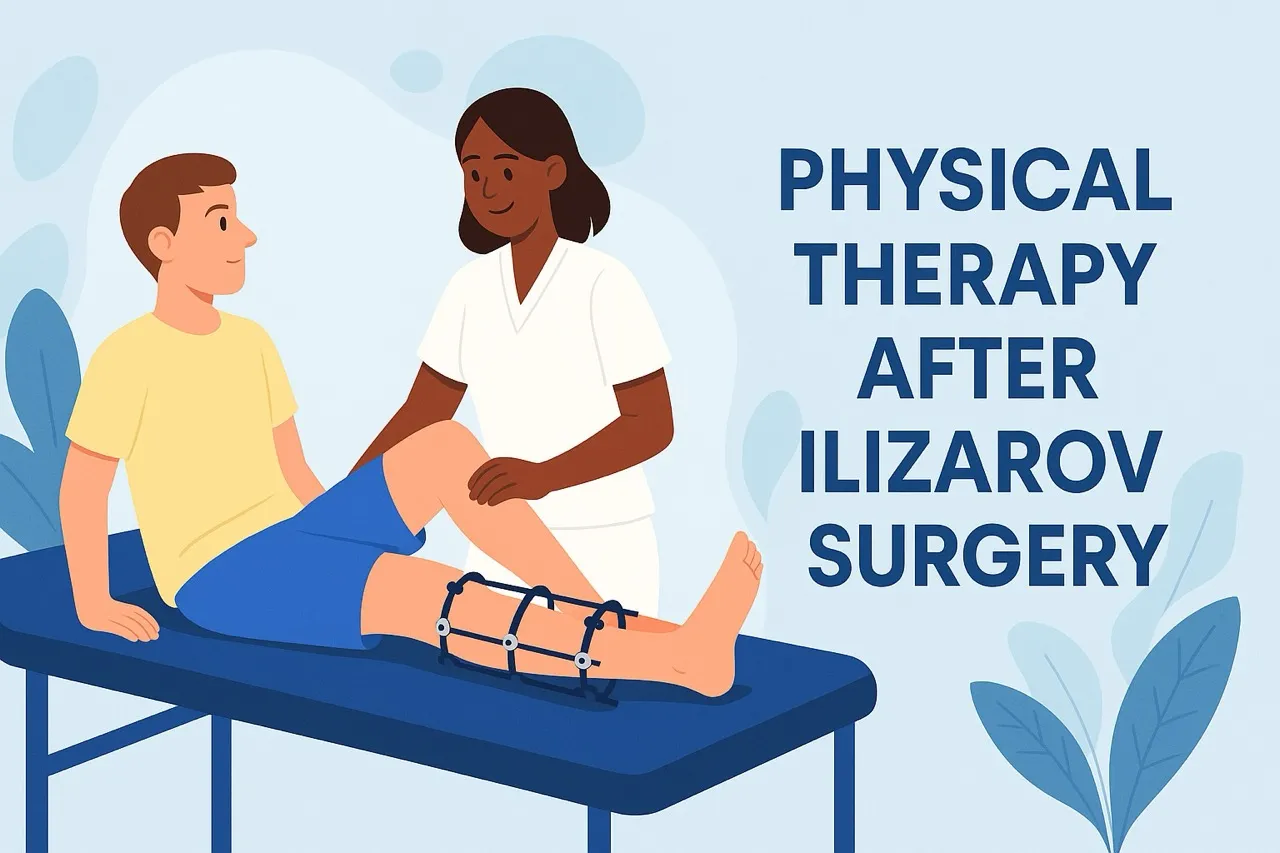Table of Contents
Introduction
Recovering from Ilizarov surgery doesn’t end in the operating theatre – it continues through structured, progressive physical therapy.
Physiotherapy keeps your joints mobile, muscles strong, and gait steady while the bone heals.
Dr. Divya Ahuja, one of the best orthopaedic surgeons in Mumbai, emphasizes that movement is medicine during Ilizarov treatment – but it must be guided and timed correctly.
Why Ilizarov Physiotherapy Matters After Ilizarov Surgery
- Prevents stiffness: Joints near the fixator (knee, ankle, hip) can easily become stiff without movement.
- Maintains circulation: Gentle exercises boost blood flow and healing.
- Strengthens muscles: Prevents wasting during long fixation periods.
- Improves bone regeneration: Controlled mechanical loading stimulates callus formation.
- Restores balance & gait: Enables safe walking with crutches or a walker.
“A well-planned physiotherapy program can reduce recovery time by nearly 30 %.” – Dr. Divya Ahuja
Phases of Ilizarov Treatment & Exercise Goals
Ilizarov rehabilitation is divided into two major stages: Distraction and Consolidation.
Each stage requires a tailored exercise plan to match bone biology and patient comfort.
1. Distraction Phase (Bone Lengthening / Realignment Stage)
Timeline: Begins around 5–7 days post-surgery and continues until the desired bone length or correction is achieved.
Primary Goals
- Maintain full joint mobility around the fixator
- Prevent muscle tightness
- Encourage gentle muscle activation without stressing the new bone gap
Recommended Exercises
Joint Mobility
- Ankle pumps – 20 reps every hour to prevent stiffness and swelling
- Knee bends (within pain-free range)
- Hip flexion and abduction (lying or seated)
- Toe curls and extensions

Muscle Strengthening
- Quadriceps sets – tighten thigh muscles for 5 seconds, relax; repeat 20 times
- Gluteal squeezes – strengthen hips for 5 seconds each rep
- Static hamstring contractions – gentle tightening without knee movement

Circulation & Edema Control
- Elevate the limb on a pillow
- Perform gentle limb shakes and ankle movements every hour
Gait Training
- Begin non-weight-bearing walking with a walker or crutches as advised
- Gradual partial weight bearing once X-rays show stable distraction
Tip from Dr. Ahuja: “Pain or clicking in the frame means you’re overdoing it. Stop, rest, and resume slower.”
2. Consolidation Phase (Bone Hardening Stage)
Timeline: After lengthening ends, the bone regenerates and hardens (usually 8–16 weeks).
Primary Goals
- Restore the full range of motion
- Strengthen limb muscles
- Retrain balance and gait
- Build endurance and confidence for normal activities
Recommended Exercises
Joint Mobility (Full Range)
- Active and assisted knee flexion/extension
- Ankle circles, dorsiflexion, and plantar flexion
- Hip rotations and side lifts
Muscle Strengthening
- Straight-leg raises in all directions
- Resistance band exercises for quadriceps and hamstrings
- Weight-bearing mini-squats (if permitted by surgeon)
- Calf raises on both feet to improve ankle stability
Balance & Gait Training
- Progress from two-crutch to single-crutch to stick walking
- Practice heel-to-toe gait once full weight bearing is allowed
- Step-up training on low stairs or blocks
Functional Activities
- Gentle cycling or stationary bike (after surgeon clearance)
- Hydrotherapy or pool walking – excellent for muscle tone and confidence
When to Begin Physiotherapy
| Stage | Start Time | Supervision Level |
| Early Post-Op (Day 2–5) | Passive ankle & toe movements | Physiotherapist-guided |
| Distraction Phase | After day 5–7 | Daily light exercises |
| Consolidation Phase | After the X-ray shows a solid union | Progressive strengthening |
| Frame Removal & Rehab | After X-ray shows a solid union | Full functional training |
Post-op Rehab Stages
| Stage | Start Time | Supervision Level |
|---|---|---|
|
Early Post-Op (Day 2–5)
Passive ankle & toe movements
|
Passive ankle & toe movements | Physiotherapist-guided |
|
Distraction Phase
After day 5–7
|
After day 5–7 | Daily light exercises |
|
Consolidation Phase
When X-ray shows solid union
|
After the X-ray shows a solid union | Progressive strengthening |
|
Frame Removal & Rehab
After X-ray confirms union
|
After X-ray shows a solid union | Full functional training |
Never start weight-bearing without a surgeon’s approval. Early or excessive loading can disrupt regenerative bone.
Common Physiotherapy Components Explained
Joint Mobility
Regular movement prevents capsule tightening. Joints above and below the frame must stay flexible.
Muscle Strengthening
Isometric → isotonic → resistance progression. Strong muscles protect the bone and reduce fatigue once the frame is off.
Gait Training
Begins as soon as the patient can balance safely. Use crutches first; re-educate walking pattern to avoid limp.
Progression After Frame Removal
- Continue physiotherapy for 6–12 weeks post-frame removal.
- Focus on stretching, balance drills, cycling, and stair climbing.
- Rebuild confidence and proprioception – many patients fear putting weight initially.
- Final phase: sports-specific or work-specific reconditioning.
Dr. Divya Ahuja – Best Orthopedic Surgeon in Mumbai for Ilizarov & Limb Rehabilitation
Dr. Divya Ahuja is widely regarded as one of the leading orthopaedic surgeons in Mumbai and Thane, specializing in:
- Ilizarov surgery & limb lengthening
- Deformity correction and bone reconstruction
- Non-union and bone infection management
His holistic approach combines advanced surgical techniques with personalized physiotherapy protocols.
Patients at his Mumbai and Thane clinics receive structured exercise charts, video guidance, and follow-ups to ensure confident recovery at every stage.
Key Takeaways
- Start gentle movement early, but never without supervision.
- Distraction phase = mobility + circulation + light activation.
- Consolidation phase = strength + balance + endurance.
- Gradually progress to full weight bearing as cleared by your surgeon.
- Consistency and correct technique are more important than intensity.
Our Clinical Locations
Tap a location to view timings, contact, and map.
Broadway Healthcare, Dadar East
Broadway Healthcare, Dadar East
Clinic Info
- 📍 Broadway Healthcare, Dadar East, Mumbai
- 🕒 Wednesdays · 10:00 AM – 12:00 NOON
- 📞 Appointments: +91 93213 17227
Sweet Clinics, Vashi, Navi Mumbai
Sweet Clinics, Vashi, Navi Mumbai
Clinic Info
- 📍 Sweet Clinics, Vashi, Navi Mumbai
- 🕒 Fridays · 10:00 AM – 12:00 NOON
- 📞 Appointments: +91 93213 17227
Heal Well Speciality Clinic, Thane West
Heal Well Speciality Clinic, Thane West
Clinic & OPD Info
- 📍 Heal Well Speciality Clinic, Thane West
- 🕒 Every Wednesday 10:00 AM – 11:00 AM
- 📞 Appointments: +91 81691 04438
Mangal Anand Hospital, Chembur Mumbai
Mangal Anand Hospital, Chembur Mumbai
Clinic & OPD Info
- 📍 Mangal Anand Hospital, Chembur Mumbai
- 🕒 Monday, Wednesday, Friday 03-07 PM, Thursday 06-07 PM, Free OPD Saturday 02-04 PM
- 📞 Appointments: +91 70212 18182
FAQs
When should I start exercises after Ilizarov surgery?
Usually, within 3–5 days, under a physiotherapist’s guidance, focusing on gentle joint movements.
Are exercises painful during the distraction phase?
Mild stretching pain is expected, but sharp pain or clicking in the frame means stop and consult your doctor.
Can I do gym workouts during the frame period?
Light upper-body exercises are allowed; avoid lower-limb weights until cleared.
How long does physiotherapy continue after frame removal?
Most patients continue structured rehab for 2–3 months to regain full strength and balance.
Is physiotherapy mandatory?
Yes – without it, stiffness and weakness can delay healing and make walking difficult later.









